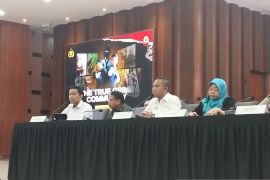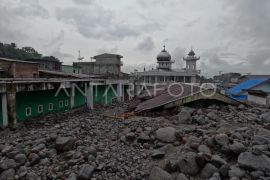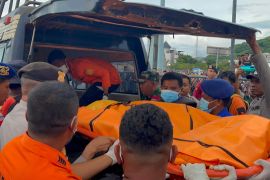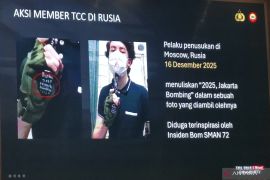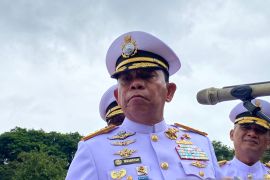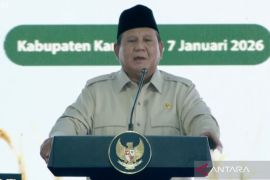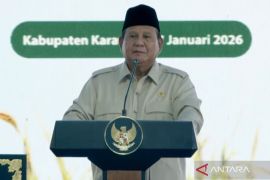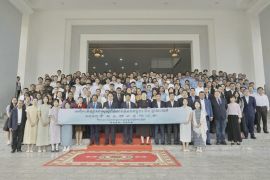The district is also endowed with abundant mineral resources, such as oil, gas, copper, iron ore, silver and gold, in addition to extensive marine resources.
Made up of many large and small islands, Southwest Maluku features luxuriant vegetation, coralline, and fine beaches lined with swaying coconut trees.
The district is spread over 9,000 square kilometres, with the sea accounting for 89 percent of the total area, and it is inhabited by approximately 100,000 people.
Babar, Luang, Leti Moa Lakor (Lemola), Damer, Romang, Kisar, and Wetar are the main islands, each with its own typical characteristics and potential.
Babar Island has a maximum elevation of approximately 750 metres and is lightly covered with sub-tropical montane forests with a distinctive topography.
"For independent travellers, visiting the islands of Babar can be a real treat, especially for those yearning for cultural immersion," said Daud Unawekla, a local resident.
Hosting a rich ecosystem and dense forests, Babar islands are also known for traditional ikat weaving and woodcarving, he added.
Unlike Babar, the tiny and largely barren Luang island has only two villages but it has managed to preserve its historical relics and crafts.
Once famous for producing the finest wooden statues in Eastern Indonesia, Lemola islands are now better known for their high quality livestock.
Moa is the largest island in Lemola, and has been chosen as the site for Southwest Maluku district`s administrative centre. However, Wonreli in Kisar island continues to be the district capital.
Kisar is culturally and geographically closer to Timor than to the rest of Maluku. Not surprisingly, it has a Timorese feel to it, with villages scattered across the dry, scrubby interior rather than along the coast.
The island is also noted for some of the finest ikat weaving in all of Indonesia, the best quality being produced by the people of Oirata village, which also has a few unusual, traditional-style houses.
During the Dutch colonial era, the Southwest Maluku islands were known as "Zuidwester-eilanden" or `Pulau-pulau Selatan Daya`, home to the finest carved wooden statues and ikat cloths.
"But sadly, most of these traditional items no longer exist and the best chance of seeing some of them is at European museums," said Edi Laudiun, a former Royal Netherlands Indies Army member who spent many years in Arnhem, the Netherlands.
Besides the abundant oil and gas resources in Masela block, the rugged, forested, and sparsely populated Wetar and Romang islands are also rich in copper, silver, and gold deposits.
Wetar island is the centre of gold mining activities in Southwest Maluku and has the second-largest gold mine in Indonesia, the largest being the gold mine of Freeport Indonesia in Tembagapura, Papua.
However, the people of Wetar are still living in rickety huts with crumbling clay walls and leaky roofs made of dried coconut leaves.
"Our huts are indeed built on soil that has fragments of gold, but we are still poverty-stricken. Our precious metal was taken away but we got nothing in return," said Johanis Tilukay, a local elementary school teacher.
The mining company dredged gold and silver out of Wetar island without providing the locals with reasonable housing, roads, bridges, or public infrastructure, he pointed out.
Meanwhile, on Romang island, Australian-based Robust Resources Limited is exploring highly prospective ground,� previously explored by Billiton (in the late 1990s) and the Asthon Mining Group, using owner-operated diamond drill rigs.
Extensive deposits of gold, zinc, silver, lead, and copper have been identified within the current drilling programme on Romang island.
Robust Resources has two large projects on Romang Island, both focusing on volcanic centres: Lakuwahi in the southern part of the island includes the key prospect areas of Batu Mas, Batu Hitam and Batu Jagung, while North Romang includes Wyaru and Kiahar.
Robust announced on in its website, www.prnewswire.com, that the company had made substantial progress with regard to its ongoing exploration and development project in Romang Island.
In January 2012, the company released its maiden Joint Ore Reserves Committee (JORC) compliant mineral resources estimate, on the basis of which it would conduct project development studies for both precious and base metals.
The estimate contains 1.18 Moz gold equivalent in JORC Indicated and Inferred categories, including 592,000 ounces gold and 27.7 million ounces silver,� the company declared.
Base metals within the polymetallic sulphide resource shell total 697 million pounds lead, 678 million pounds zinc, and 95 million pounds copper, it said.
As important a milestone as this resource estimate is for the company, it is considered to be but an opening chapter in the book that represents the entire mineral potential of Romang Island,� the company added.
To further unlock that potential, Robust has commenced a large drilling campaign for 2012, using all the financial, human and material assets at its disposal.
The company has also started a major new exploration drilling programme designed to test fresh targets, as well as follow up extensions to the known mineral deposits.
The programme was expected to run throughout 2012 and involved using 8-10 exploration diamond drill rigs in both the northern and southern part of Romang Island.
Speaking about the precious metals exploration by Robust subsidiary PT Gemala Borneo Utama (GBU) on the island of Romang since 2006, local youth figure Yesayas Petruzs said it had resulted in extensive environmental damage and was likely to cause catastrophic consequences for the local community.
Therefore, he added, the people of Romang had urged the local government to stop Robust Resources Limited from continuing its gold mining activities.
"Romang is a small island with an area of 172 sq km but the entire island is rich in gold and silver minerals. If the drilling activities are not restricted, the island will sooner or later disappear," Yesayas said.
Meanwhile, local residents expressed despair that they could benefit from the rich resources of Southwest Maluku district.
"Poverty remains widespread among rural households in remote islands, with countless number of people living in impoverished conditions," they said.
Despite its immense mineral, natural, and marine resources, Southwest Maluku is still one of the poorest districts with high poverty and unemployment rate.
Nearly 70 percent of the district`s population work in agriculture, fishery and the informal economy, with uncertain daily income. And most of the time it is not enough for the households to meet their daily need of food, clothing, basic health care, and education for their children, local political figure Simon Moshe Maahury said.
"Thousands of small farmers, farm workers, and fishermen in the district are materially and financially unable to tap into the opportunities offered by years of economic growth in the country," he pointed out.
They are geographically isolated and therefore lack access to agricultural extension services, markets and financial services, Simon explained.
In many villages across the Southwest Maluku district, the farmers eke out a subsistence existence. Therefore, development programmes must be launched to help them deal with the many challenges they face. (*)
Reporter: Otniel Tamindael
Editor: Otniel Tamindael
Copyright © ANTARA 2012
